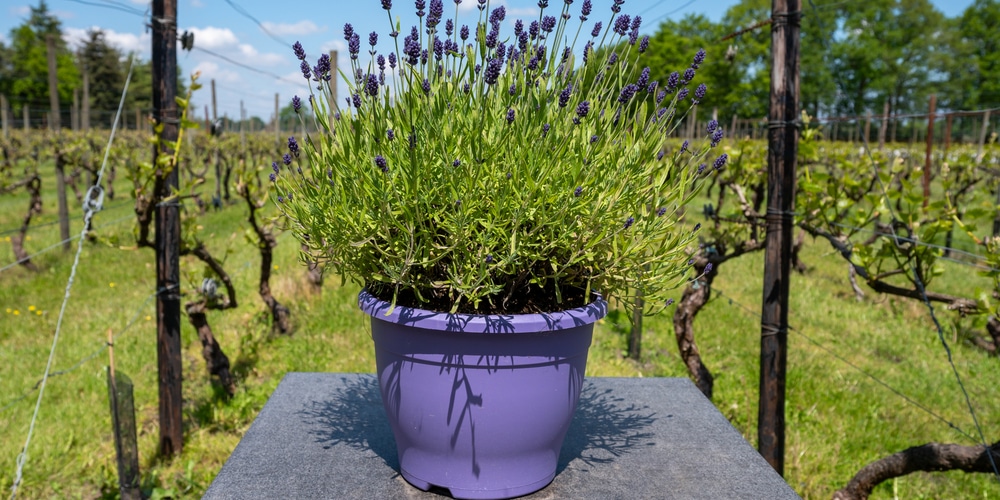Do you want to plant lavender in North Carolina? North Carolina lavender growers recommend planting lavender in the spring, after the last frost date.
Lavender requires full sun and well-drained soil. Prepare the soil for planting with organic matter before planting. Set plants 12 to 18 inches apart, and water them well.
Mulch lavender plants help retain moisture and keep the roots cool during hot weather.
North Carolina USDA hardness Zones and frost time

North Carolina’s growing zones often range from 5b to 8b. This means that the last frost date can be as early as October 27 for most of Central North Carolina but a few weeks earlier for places such as Oxford, Roxboro, Henderson, and Louisburg.
For areas like Clinton and Fayetteville, the first frost is normally experienced within the first days of November. The average last frost date is usually around April 1.
Why is planting time such an important factor?
The time of year that you choose to plant your lavender will have a big impact on how well it grows. Lavender is a Mediterranean plant, which means it thrives best under hot, dry summers and cool, wet winters.
If you live in an area with a climate similar to this, you can plant lavender any time of year.
If you live in an area with a hot summer and a cold winter, it’s best to plant lavender in the spring so it has a chance to get established before the frozen winters arrive.
Lavender isn’t able to survive cold or frost weather under 40 degrees Fahrenheit. So if you plant them outdoor too early in spring, they’ll die. And when you plant them late, they won’t produce harvest before the frost arrives in the fall.
When you live in an area with a mild climate, the best time to plant lavender is in the fall. This gives the plant a chance to become established before the hot summer arrives.
If you’re unsure when the last frost date is in your area, you can check with your local Cooperative Extension Office. They will be able to tell you when the average last frost date is in your area.
Spacing and Irrigation for Lavender
Space plants 12 to 18 inches apart. Water well after planting, and keep the soil moist (not wet) until plants are established. This plant prefers well-drained soil—lavender doesn’t like wet feet!
If your soil is heavy, mix in some sand to improve drainage. Once plants are established, lavenders are drought-tolerant and will need watering only during prolonged periods of dryness.
Lavender also requires at least 6 hours of direct sunlight a day to thrive, so make sure to plant it in a sunny spot.
Fertilizing and Pruning
Lavender is a light feeder and doesn’t require much fertilizer. You can fertilize lavender plants in the spring with a balanced fertilizer, such as 10-10-10. Follow the directions on the package.
Pruning is essential to keeping your lavender plants healthy and looking their best. Lavender blooms on new growth, so you’ll need to prune it back each year to encourage fresh growth and more flowers.
The best time to prune lavender is in the spring, after the last frost date. Cut plants back by one-third to one-half their height.
Harvesting and Drying Lavender
Lavender is ready to harvest when the flowers are in full bloom and before they start to fade. Cut stems with a sharp knife or pruning shears, and bundle them with twine.
Hang the bundles’ upside down in a dark, dry place to finish drying. Once the lavender is completely dry, you can remove the flowers from the stems and store them in an airtight container.
Lavender flowers can be used fresh or dried in a variety of ways. Add them to salads, use them to make lavender sugar or lavender-infused honey, or brew them into tea.
Uses Of Lavender
Lavender is also a popular choice for gardens. It is a beautiful and versatile plant that can be used in many different ways. Whether you’re using it for its fragrance, flavor, or medicinal properties, lavender is a great plant to have in your garden.
Lavender can be harvested and used to make tea, potpourri, sachets, and other fragrant products. The flowers can also be used to decorate cakes, cookies, and other desserts. Lavender oil can be used in aromatherapy, massage, and cosmetics. The oil is also used to flavor food and drinks.
Related Article: How Long Does it Take to Grow Lavender From Cuttings?

